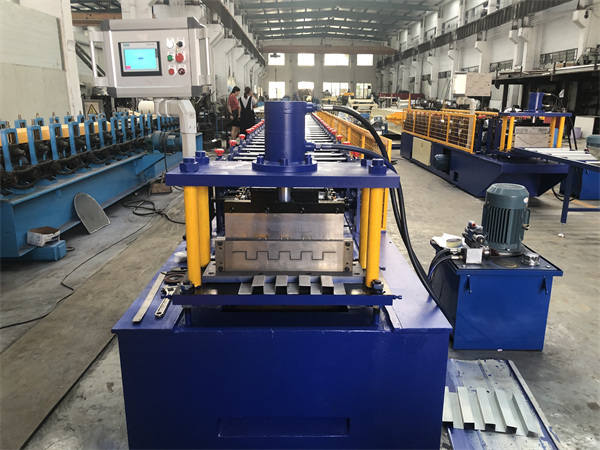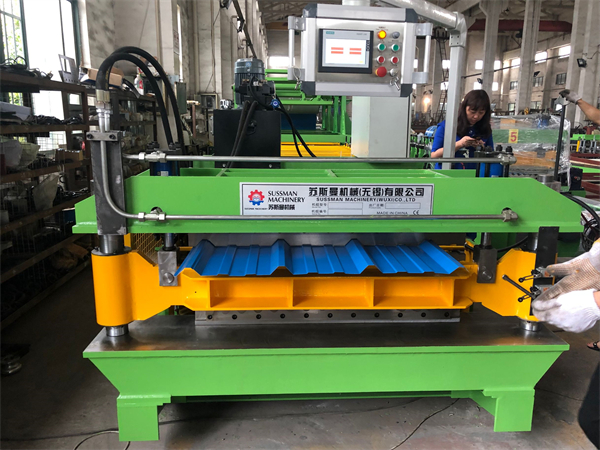1. परिचय
In the realm of metal forming processes, stamp roll forming machines play a significant role in transforming flat metal sheets into complex, functional profiles. This article delves into the world of stamp roll forming, exploring its working principles, benefits, applications, types, and more. Let’s embark on a journey to understand how this versatile machine has revolutionized the manufacturing industry.
2. What is a Stamp Roll Forming Machine?
A stamp roll forming machine is a manufacturing marvel used to shape metal sheets into continuous profiles with consistent cross-sections. By feeding a metal strip through a series of rolling dies, the machine progressively bends and forms the metal into the desired shape. This process is highly efficient, cost-effective, and yields precise results.
3. How does a Stamp Roll Forming Machine work?
The stamp roll forming process involves several essential steps, including material feeding, roll forming stations, and cut-off operations. The machine’s roll stands, equipped with sets of rollers, gradually shape the metal strip as it passes through each station. The final product emerges as a continuous profile with the desired specifications.

4. Benefits of Using a Stamp Roll Forming Machine
4.1 Increased Production Efficiency
Stamp roll forming machines boast high production rates, making them ideal for large-volume manufacturing. The continuous forming process ensures a steady output, reducing production time and boosting overall efficiency.
4.2 Cost Savings
Stamp roll forming eliminates the need for secondary operations, minimizing material waste and labor costs. Moreover, the precision and repeatability of the process contribute to fewer defective parts and lower scrap rates.
4.3 Versatility and Customization
With versatile tooling options, stamp roll forming machines can produce an extensive range of profiles. Manufacturers can customize the design, length, and thickness of profiles to meet specific project requirements.
4.4 Consistent and High-Quality Output
The roll forming process ensures uniformity in the final product, resulting in consistent quality across the entire production batch. This reliability is crucial for industries with strict quality standards.
5. Applications of Stamp Roll Forming Machines
5.1 Automotive Industry
The automotive sector extensively employs stamp roll forming for manufacturing vehicle components like fenders, bumpers, and structural reinforcements.
5.2 Construction Industry
In construction, stamp roll forming is used to produce roof panels, wall claddings, and framing components for buildings.
5.3 Electronics Industry
Stamp roll forming contributes to the production of electronic enclosures, brackets, and chassis components, meeting the demands of modern technology.
5.4 Aerospace Industry
Precision and durability make stamp roll forming indispensable for aerospace applications, such as aircraft fuselage components and engine casings.
6. Types of Stamp Roll Forming Machines
6.1 Single-Station Stamp Roll Forming Machine
A single-station machine is suitable for simpler profiles and low-volume production, making it a cost-effective choice for small-scale projects.
6.2 Double-Station Stamp Roll Forming Machine
Double-station machines increase productivity by allowing two sets of rollers to work simultaneously, reducing cycle times and accommodating higher volumes.
6.3 Triple-Station Stamp Roll Forming Machine
Triple-station machines are capable of producing complex profiles in a single pass, ideal for intricate designs and time-sensitive projects.

7. Factors to Consider when Choosing a Stamp Roll Forming Machine
7.1 Material Thickness and Width
The machine’s capacity to handle the material’s thickness and width should align with the desired profile specifications.
7.2 Roll Forming Speed
Choosing the appropriate roll forming speed ensures optimal production rates without compromising quality.
7.3 Tooling and Die Options
The availability of various tooling and die options determines the machine’s flexibility in producing different profiles.
7.4 Automation Features
Automation enhances productivity and reduces the dependency on manual labor, resulting in higher efficiency.
7.5 Maintenance and Support
Considering the ease of maintenance and access to technical support is essential to ensure uninterrupted operations.
8. Common Challenges in Stamp Roll Forming
8.1 Material Springback
Material springback can cause dimensional variations in the final product, necessitating corrective measures.
8.2 Dimensional Variations
Ensuring consistent dimensional accuracy can be challenging, especially for longer profiles.
8.3 Surface Imperfections
Addressing surface imperfections, such as scratches or dents, requires strict quality control measures.
8.4 Tooling Wear
Regular monitoring and maintenance of tooling are crucial to prevent premature wear and maintain profile accuracy.
9. Tips for Optimizing Stamp Roll Forming Processes
9.1 Proper Material Selection
Choosing the right material with suitable properties ensures the integrity and performance of the final product.
9.2 Precision Tooling Design
Well-designed tooling guarantees precise and repeatable profiles, minimizing variations.
9.3 Regular Equipment Maintenance
Scheduled maintenance enhances machine longevity and minimizes downtime.
9.4 Quality Control Measures
Implementing robust quality control practices helps identify and rectify defects early in the production process, ensuring that only high-quality profiles are delivered to customers.

10. Safety Precautions for Operating a Stamp Roll Forming Machine
Operating a stamp roll forming machine requires strict adherence to safety protocols to prevent accidents and injuries. Some essential safety precautions include:
- Proper Training: Operators must undergo thorough training to understand the machine’s operation and safety procedures.
- Protective Gear: Operators should wear appropriate personal protective equipment, such as safety glasses, gloves, and hearing protection.
- Machine Guards: Ensure all moving parts are properly guarded to prevent accidental contact during operation.
- Emergency Stop: The machine should be equipped with an easily accessible emergency stop button to halt operations in case of emergencies.
- Regular Inspections: Regularly inspect the machine for any signs of wear or damage, and address any issues promptly.
11. Future Trends in Stamp Roll Forming Technology
As technology continues to evolve, stamp roll forming machines are also witnessing advancements to meet the demands of modern manufacturing. Some emerging trends include:
- Integration of AI and IoT: Artificial Intelligence (AI) and the Internet of Things (IoT) will enable real-time monitoring and data analytics, optimizing production processes and minimizing downtime.
- 3D Printing in Tooling: Additive manufacturing techniques like 3D printing will revolutionize tooling design, allowing for more complex and customized profiles.
- Enhanced Material Compatibility: Future machines will be able to process a broader range of materials, expanding their applications further.

12. निष्कर्ष
Stamp roll forming machines have proven to be a game-changer in the metal forming industry. With their efficiency, cost-effectiveness, and versatility, they have enabled manufacturers to produce complex profiles with precision and consistency. From automotive to aerospace applications, these machines continue to shape various industries, driving progress and innovation. As technology advances, stamp roll forming will only become more efficient and adaptable, cementing its position as a crucial metal forming process.
पूछे जाने वाले प्रश्न
13.1 What materials can be processed with a stamp roll forming machine?
Stamp roll forming machines can process various materials, including steel, aluminum, copper, and stainless steel.
13.2 Is stamp roll forming suitable for high-volume production?
Yes, stamp roll forming is highly suitable for high-volume production due to its continuous and efficient forming process.
13.3 How does stamp roll forming compare to other metal forming processes?
Compared to other metal forming processes, stamp roll forming offers superior precision, consistency, and cost-effectiveness.
13.4 Can stamp roll forming be used for curved or complex profiles?
Yes, stamp roll forming is capable of producing curved and complex profiles, making it a versatile solution for various design requirements.
13.5 What are the main advantages of automated stamp roll forming systems?
Automated stamp roll forming systems offer increased productivity, reduced labor costs, and improved quality control, making them highly advantageous for modern manufacturing operations.
